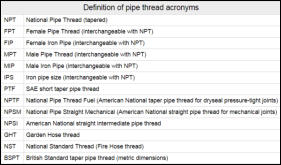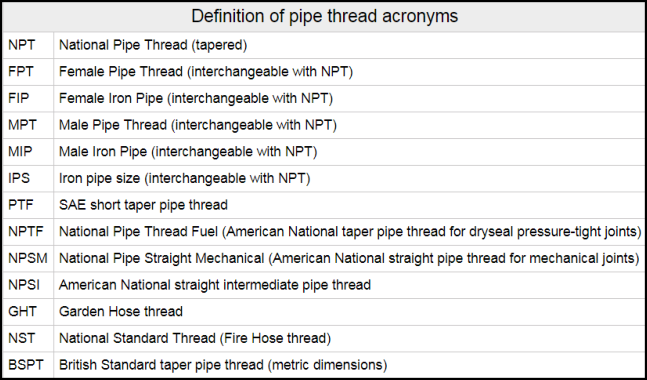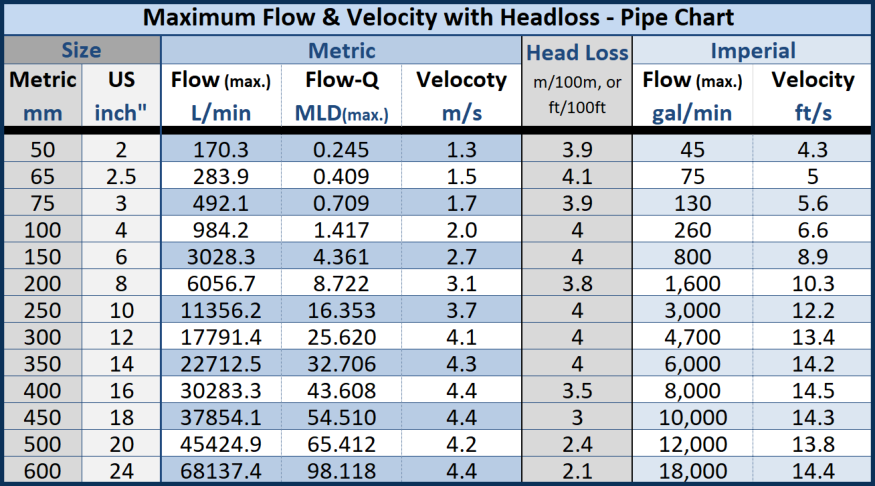



OETC Operator & Course Resources

© OETC - All Rights Reserved
Pipe Sizes & Threading Information
BSP
BSP thread form stands for British Standard Pipe and is common in Australia and the
commonwealth countries. It is based on trade size rather than actual diameter which can lead to
some confusion when measuring ports.
There are two types of BSP threads;
- Parrallel (BSPP) - also known as G or Rp
- Tapered (BSPT) - also know as R or Rc
Both threads have the same pitch, angle (55 degrees) and shape (rounded peaks and valleys).
The below table gives the major and minor diameter for each BSP Trade Thread Size.
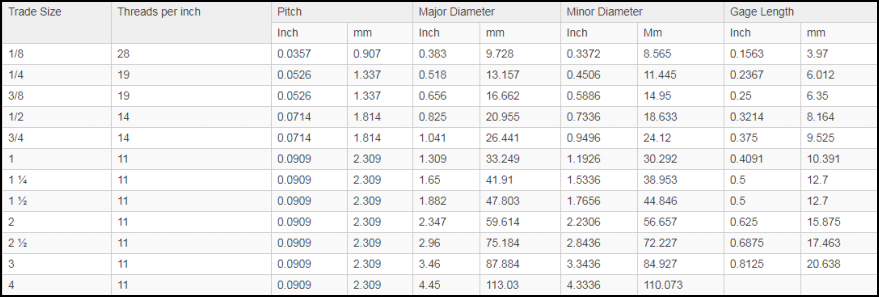
NPT
NPT stands for National Pipe Thread and is an American standard thread. It may also be reffered
to as MPT , MNPT or NPT (M) for male external threads and FPT, FNPT or NPT(F) for female
interal threads. A thread sealant must always be used to achieve a leak free seal (except for
NPTF). It is also based on Trade Size rather than actual diameter (similar to BSP in this regard).
Both threads have the same pitch, angle (60 degrees) and shape (flat peaks and valleys).
The below table gives the Threads Per Inch, Pithc and Major Diameter for NPT Threads.
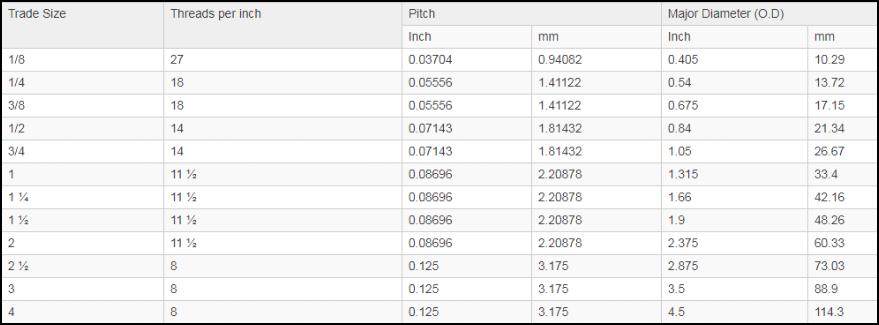
BSP vs NPT
NPT threads are common in the United States and a few other countries, BSP threads are widely
used in many other countries.
BSPT -British Standard Pipe Taper
BSPP -British Standard Pipe Parallel
NPT -National Pipe Taper
NPS -National Pipe Straight
While the actual specified outside diameters of American
National Pipe differ slightly from those of British Standard
Pipe, either thread may reliably be cut onto a pipe of its
respective trade size. BSPT equivalent is NPT and BSPP’s
equivalent is NPS.
Never swap threads if it is a high pressure application.
NPT/NPS and BSP threads are not compatible due to the
differences in their thread forms, and not just the fact that
most sizes have a different pitch. NPT/NPS threads have a
60° angle and have flattened peaks and valleys (Sellers
thread form) where as BSP threads have a 55° angle and have rounded peaks and valleys
(Whitworth thread form).
NPT and BSP thread pitches (threads per inch) are listed below. To determine pitch, use a thread
gauge or count the number of threads that fall into a 1" span.
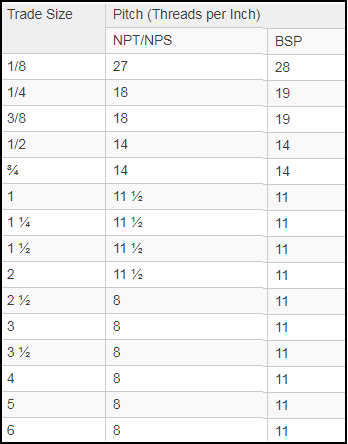
In plumbing pipe size is referred to as nominal pipe size - NPS, or
"Nominal Pipe Size". The metric equivalent is called DN or "diametre
nominel". The metric designations conform to International Standards
Organization (ISO) usage and apply to all plumbing, natural gas, heating oil, and miscellaneous
piping used in buildings. The use of NPS does not conform to American Standard pipe
designations where the term NPS means "National Pipe Thread Straight".
ISO 6708 - Pipework components - Definition and selection of DN (nominal size)
ISO 6708 defines the nominal size - DN - as an alphanumeric designation of size for reference
purposes. It comprises the letters DN followed by a dimensionless whole number which is
indirectly related to the physical size in millimetres of the bore (ID) or outside diameter (OD) of
the end connections.
Outside diameters for metric and imperial standards are indicated in the table below.
Pipe Sizes
Derived from: Engineering Toolbox
Pipes are made of a wide variety of materials - like galvanized
steel, black steel, copper, cast iron, concrete, and various plastics
such as ABS, PVC, CPVC, polyethylene, polybutylene and more.
Pipes are identified by "nominal" or "trade" names that are loosely
related to the actual dimensions. For instance, a 2-inch galvanized
steel pipe has an inside diameter of about 2 1/8 inches and an
outside diameter of about 2 5/8 inches.
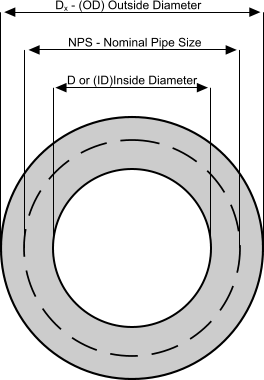

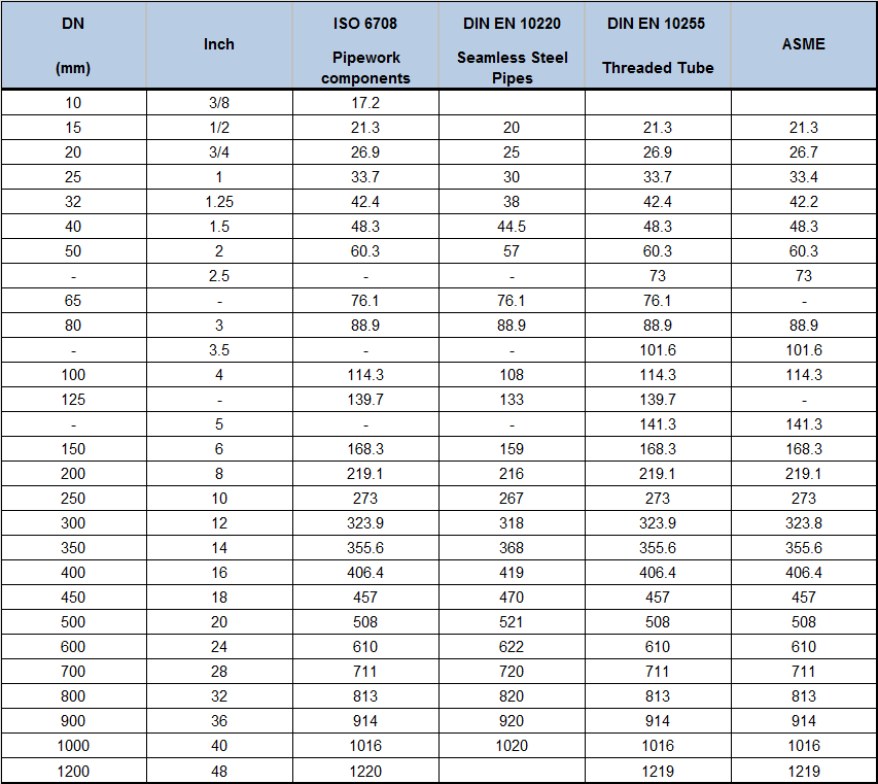
Pipe Threads
Derived from various sources: 1) https://www.valvesonline.com.au/references/threads/ 2) https://www.plumbingsupply.com/pipethreadsizing.html
National Pipe Threads (NPT) have tapered threads. These are the
most common threads used for general purposes. NPT threads are
designed with a 60 degree thread angle, and are used for joining
and sealing pipe to fittings in low pressure air or liquids and also
mechanical applications. The tapered thread is 3/4" over one foot
of length. Tapered threads are deeper at the end of the pipe and
are increasingly shallower the further they are from the end of the
pipe. The taper on the pipe only allows the pipe to screw inside the fitting until it is forced to stop
because of the taper. The distance the pipe can be screwed into the fitting is specified by the ANSI
standard. After tightening with a wrench the threads may have slight spaces between the pipe and
fitting which could cause a leak so a pipe sealant must be used to ensure any gaps are filled.
The Dry-seal thread (NPTF) also have tapered threads. NPTF threads are used when the
application is such that pipe sealing compounds may fail due to higher heat or pressure than
normal NPT threads can withstand. The threads are designed to seal mechanically by slightly, but
sufficiently, crushing the threads when tightened with a wrench. This allows for joining the pipe and
fitting without sealants.
The NPT and NPTF threads can be interchanged if sealants such as PTFE tape or suitable pipe
joint compounds are used. None of the other thread standards are fully interchangeable (GHT,
NST, BSPT, NPSI, etc.) Female NPT threads can be designated as "FPT" or "FIP" and male NPT
threads can be designated as "MPT" or "MIP".
National Standard Free-Fitting Straight Mechanical Pipe Threads (NPSM) have straight threads
which are only used for joining. A washer or gasket is needed to seal this type of threaded
connection.
There are also three less common thread types used in the plumbing industry. The Garden Hose
Thread (GHT) and the Fire Hose Thread (NST) have coarse threads. The seal is made with a
gasket or washer and are used mainly for attaching (joining) hoses to valves quickly, without the
use of a wrench. The British Standard Taper Pipe Thread (BSPT) has a 55 degree thread angle
(NPT are 60 degree) and is used internationally as a standard thread for joining steel pipes.
